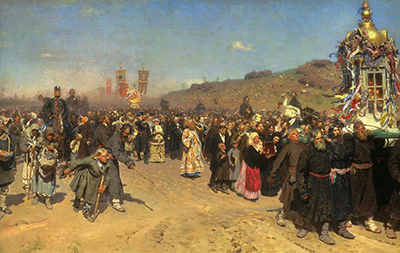The Russian realist Ilya Repin awes the spectator with this large and incredibly detailed oil painting.
At two hundred and eighty centimeters from end to end, and one hundred and seventy five centimeters from top to bottom, this painting takes up a lot of wall space. Which such an expansive canvas, Repin has plenty of space to include all of the characters who made up the social spectrum in post reformation Russia at the end of the 19th century.
The painting is dominated by golden tones: the sun baked dust being kicked up by the large procession of humans and horses creates an auriferous cloud that hangs over the crowd. There are also the flowing robes of the clergymen and the highly held processional banners which are full of golden details. Then of course there is the religious icon itself -the Kursk Root Icon or the Our Lady of Kursk- that is housed in an elaborate neoclassical carrying case known as a kiot with a brilliant vaulted gold dome.
The story of the icon itself is quite amazing. It is one of the oldest Russian religious icons, and dates back to at least September 8th in the year 1259 (although the exact year is disputed in some theological circles). On that day a hunter pursuing ducks found the painting lying face down against a tree root. As he pulled the magnificent blue and gold wooden painting up from against the root, a spring of crystalline burst forth. The man who made the discovery called forth the others in his hunting party to observe this miracle.
Shortly thereafter these men erected a small wooden chapel to house this religious icon which featured the Theotokos or sign of the Mother of God with her arms outstretched. Above her is the heavenly father while below her is the Christ Child, in a formation that suggests the holy trinity. Around the perimeter of this religious painting are the nine prophets who foretold the birth of Christ: Daniel, Jeremiah, Elijah, Habakkuk, Judge Gideon, Prophets Isaiah, Moses, and King David.
As important as this religious icon may have been to the faithful Russians whom venerated it and credited it with performing miracles, it is clearly of secondary importance in Repin's "Religious Procession In Kursk Province". Indeed, it is not visible at all in the painting save for the light that glints of its protective golden case which is seen through the windows of the intricate, ornate, and heavily festooned kiok.
In fact, that the kiok and the icon are seemingly being carried away out of the canvas' frame compels viewers to focus their gaze on what is really happening in the procession behind it. And what one sees in the Religious Procession In Kursk Province is a tumultuous scene in which poor peasants solemnly trod forward at the margins of the march while police and military officials on horseback contain them with shouts and even lashings from their riding crops.
One's attention can't help but immediately focus on the blond haired peasant boy with his leg lame and bandaged and his clothing in tatters who tries to limp his way forward to be closer to the icon (and thus closer to some sort of miracle ostensibly) only to be held back by an elderly peasant with an outstretched wooden stick. One of the peasants holding up the platform which supports the kiok appears to be inebriated, which caused a great stir when this painting was first unveiled.
In the procession's center column which trails directly behind the kiok are the well-to-do elites with their finely tailored suits and dresses. Among them is a priest who is shown adjusting his locks of curly hair, oblivious to the collective chaos around him. Religious Procession In Kursk Province literally depicts the carrying of the Our Lady of Kursk icon from Korennaya Monastery to the city of Kursk. However, in a deeper sense it can be seen as a portrayal of Russia's moving towards the inevitable Bolshevik revolution. Ilya Repin completed this master work some time between 1880 and 1883.




